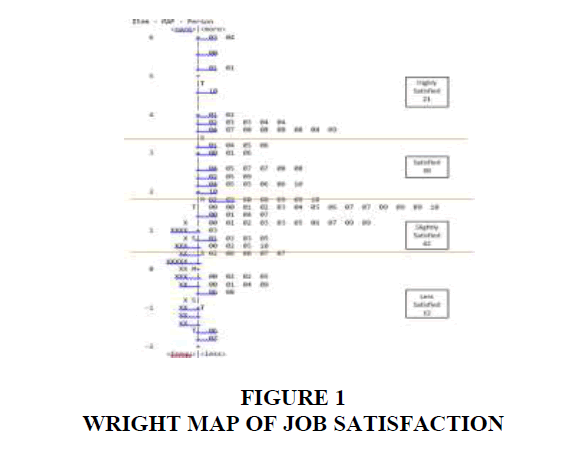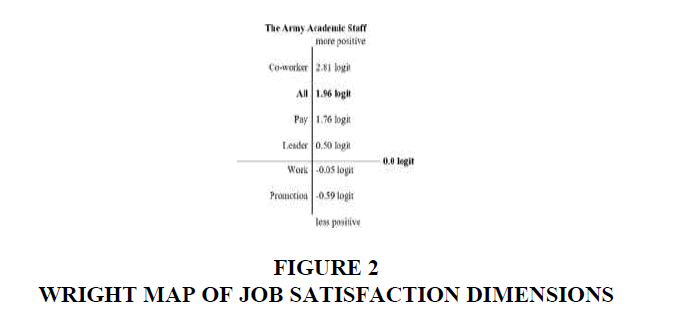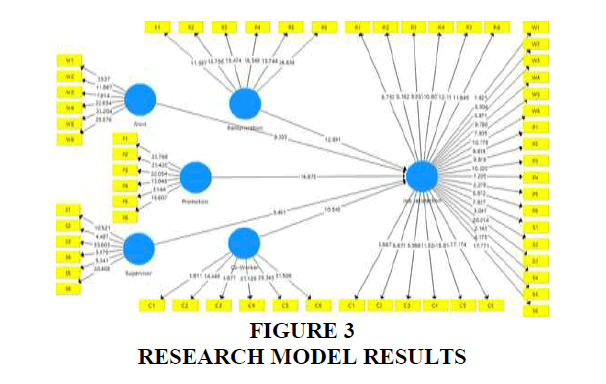Research Article: 2021 Vol: 27 Issue: 3
Public Sector Organization Analysis the Behavioral View from Indonesia
Didin Zainal Abidin, Jakarta State University
Wibowo, Moestopo University
I Ketut R. Sudiarditha, Jakarta State University
Maria Grace Herlina, Bina Nusantara University
Abstract
Job satisfaction has a significant impact on an organization's overall performance. This study aims to assess academics' job satisfaction at a public sector learning institution in Indonesia since public sector workers expected to have a service orientation, minus the economic orientation. First, the research analysis uses the Rash Analysis model to assess the test's validity and reliability objectively and provide an in-depth quantitative description. Secondly, the research hypotheses will be examined using the Structural Equation Model (SEM). The study's results indicate that public sector organizations can boost academics' work satisfaction by instituting a more effective promotion scheme since academics have voiced discontent with the promotion system. However, the research findings indicated that the revived promotion scheme could significantly impact an academic's positive feelings when performing academic duties.
Keywords
Job satisfaction, Public sector organization, Promotion, Co-worker, Remuneration.
Introduction
Job satisfaction is a global research topic. Numerous studies completed in both public and private organizations The researchers use a variety of similar and distinct analysis tools and techniques, based on the organization's nature and the demographics of the location (Barrilao et al., 2016; Ridzuan et al., 2018; Vigan & Giauque, 2018)
Globalization and economic growth are synonymous with a series of changing trends. The question of public services arises. Society needs that all state apparatus be capable of fostering an environment conducive to the efficient administration of the government's duties and functions and their activities in compliance with good governance principles. Each civil servant possesses an exceptional capacity for work, is trained, possesses positive capabilities and attitudes, possesses a good source of work inspiration, and can carry out their assigned duties and authorities (Asencio, 2016; Rafsanjani et al., 2019).
Training and development are two strategies for improving the skills of civil servants. They are subsets of the learning and development function for establishing consensus, advancing structural reform, and assisting in accomplishing strategic objectives. Learning and development foster knowledge, skills, and experience between individuals and groups through structured and unstructured learning processes. A learning organization is one in which employees constantly improve their ability to produce novel and expansive thinking patterns (Moosa et al., 2020).
The public sector learning institution is a place for public sector employees to develop new skills and knowledge. Thus, the academics of the public sector learning institution are critical to the institution's overall excellence. Additionally, the learning institution is also a learning organization. It assists public sector employees in developing their critical thinking abilities, systematic problem solving, experimentation, learning from previous experiences, learning from others, and knowledge transfer within the organization through education and training programs. It is why the public sector learning institution serves as a critical platform for sharing public sector organization knowledge (Booth-Kewley et al., 2017; Moosa et al., 2020). Thus, the study's objective is to examine academics' job satisfaction at a public sector learning institution as a public sector entity since public sector employees should have a service orientation, minus the economic exposure.
Literature Review
Human Capital in Public Sector Organization
A public sector employee defines as an individual's propensity to respond to both broad and institution-specific motivations, which include the following: (1) an engagement in public policy that inextricably connected to the quest for success and the pursuit of inner/personal fulfilment; (2) a dedication to the common good and civic obligations. This second dimension is inextricably related to the drive or ability to support the public interest and (3) empathic or caring feelings characterized by a desire to assist others. This dimension exemplified by employees who demonstrate patience when serving the group. Lastly, (4) self-sacrifice is a mindset associated with the attitude of loving one's country (patriotism), being responsible for one's duties, and remaining faithful to one's country. Employees in the public sector should be service-oriented, without the economic orientation, and genuinely involved. They should be inspired by their work's intrinsic benefits and rewards (Rafsanjani et al., 2019; Valor-Segura et al., 2020).
Job Satisfaction
Job satisfaction represents how a person feels about the services provided by his or her organization. Thus, academics' job satisfaction will serve as a barometer of a Public Sector Organization educational institution (Naveena & Geevarghese, 2019; Szromek & Wolniak, 2020). Numerous studies conducted to determine the effect of job satisfaction on engagement, mostly in for-profit organizations of all levels. The analysis of job satisfaction inside a Public Sector Organization is still uncommon, most likely due to the public sector organization's desire to maintain the secrecy surrounding its activities (Bahri et al., 2017; Ridzuan et al., 2018; Valor- Segura et al., 2020).
Five significant dimensions influence job satisfaction. There are the following: compensation, advancement opportunities, work itself, supervision, and co-worker. The majority of scholars agree that these dimensions affect job satisfaction through a positive attitude toward work situations, cooperation among co-workers, and personnel compensated for their work. These dimensions are also present in public sector organizations, which means that job dimensions impact academics in the public sector learning institution (Ridzuan et al., 2018; Romi, et al., 2021).
This research aims to conduct an in-depth examination of the academic's attitude toward work, specifically job satisfaction. It will also investigate the effect of job satisfaction dimensions on the overall job satisfaction of academics at the public sector learning institution. The following sections discuss the research hypotheses.
Hypotheses
H1: Co-Worker has a significant impact on the job satisfaction of Public Sector Academics.
H2: The promotion has a significant impact on the job satisfaction of Public Sector Academics.
H3: Remuneration has a significant impact on the job satisfaction of Public Sector Academics.
H4: The supervisor has a significant impact on the job satisfaction of Public Sector Academics.
H5: Work itself has a significant impact on the job satisfaction of Public Sector Academics.
Research Methodology
The study will look at academics' attitudes toward their jobs at the public sector learning institution in Jakarta and Surabaya. The experimental studies scheduled to conclude in December 2020. The study collected data through a job satisfaction questionnaire focusing on five distinct dimensions of job satisfaction. There are only 105 respondents from 150 academics who can examine further. They are all senior employees at the same rank (IVC/Pembina Utama Muda) in the Public Sector Organization. The majority of respondents (94.3%) were male and held a bachelor's degree (41.9%), a master's degree (26.7%), or a doctoral degree (22.9%). Job satisfaction analyzed in terms of compensation, the work itself, career prospects, supervisors, and co-workers.
First, the research carried out the Rash Model Analysis to determine the test's validity and reliability objectively and give an in-depth quantitative description. Secondly, Square Structural Equation Model (PLS-SEM) as statistical data analysis will examine the research hypotheses. Smart-PLS version 3 used for running the study to reflect the job satisfaction variable in its dimensions. The Rash Model Approach analyses the data, including the research instrument's validity and reliability test. The Rasch Model using Winstep performed in version 3.73. The Rasch model is a data analysis method that can transform ordinal responses from Likert rating scales into interval values (Miftahuddin et al., 2020). It also helps to predict the respondents' answers to be correctly predicted on all items. The Rasch Model rearranges item scores into a set of ordinal values (measure) called "unit of opportunity logarithms" (logit) (Miftahuddin et al., 2020).
The research instrument is a five-dimensional assessment of job satisfaction. These include compensation policy, advancement opportunities, work itself, supervision, and co-worker. Table 1 reveals that the Cronbach's alpha for measuring research instrument reliability is 0.94, indicating an excellent interaction between the items and the respondents' responses (Sumintono, 2014). The person's accuracy in their responses is 0.93, suggesting a consistent reaction of the respondents. The accuracy of the test item reliability is 0.90, meaning that the research instrument's items are also outstanding. The values explain that there is a firm consistency in respondents' responses, and the quality of the items is excellent to measure the research variables (Sumintono, 2014). However, the validity test results indicate two items (PR4 and F5) that are outliers as the logit values are below 0.5 and above 1.5 (Sumintono, 2014). They subtracted from the promotion and compensation dimensions.
| Table Reliability Test Of Job Satisfaction Instrument |
||||
| Summary Statistics | Person | Item | ||
| Reliability | 0.93 | 0.90 | ||
| Cronbach Alpha | 0.94 | |||
Findings and Discussion
The Rasch model is used to characterize job satisfaction for academics working at the public sector learning institution. According to the Wright Map, 40% of academics are only slightly satisfied with their academic obligations. By comparison, 20% of academics are delighted with their academic responsibilities, 28% of academics are happy with their jobs, and 11% show unhappiness with their academic responsibilities (shown in Figure 1).
Another in-depth analysis using the Rasch Model examines dimensions of job satisfaction (see Figure 2). It suggests that the academics at public sector learning institution are most satisfied with their co-workers who have the highest logit ranking (2.81 logit). It implies that the academics have a strong team spirit (esprit de corps). On the opposite, the academics were dissatisfied with the promotion scheme (-0.59 logit). It suggests that the academics at public sector learning institution do not believe that fulfilling academic obligations will help them achieve a higher public sector organizational rank.
Additionally, this study employs a Structural Equation Model (PLS-SEM) to examine how different work satisfaction dimensions contribute to overall job satisfaction. Hypothesis testing used to test the influence of exogenous dimensions on endogenous dimensions. The test criteria state that if T-statistics ≥ T-table (1.96) or the value of ρ-Value < significant α 5% or 0.05, it is noted that there is a significant influence of the exogenous dimension on the endogenous dimension. The significance and model testing results are in the following figure (Figure 3) and tables (Table 2).
| TABLE 2 Path Coefficien Value |
|||||
| Hypothesis Testing | Original Sample (O) | T Statistics (|O/STDEV|) | ρ-Value | Results | |
| H1 | Co-Worker ≥ Job satisfaction | 0.252 | 10.546 | 0.000 | Accepted |
| H2 | Promotion ≥ Job satisfaction | 0.266 | 14.673 | 0.000 | Accepted |
| H3 | Remuneration ≥ Job satisfaction | 0.260 | 12.891 | 0.000 | Accepted |
| H4 | Supervisor ≥ Job satisfaction | 0.221 | 8.461 | 0.000 | Accepted |
| H5 | Work ≥ Job satisfaction | 0.222 | 9.303 | 0.000 | Accepted |
Conclusion
Job satisfaction is a significant factor in the overall performance of an organization. According to the study's findings, public sector organizations will increase academics' job satisfaction by implementing a more effective promotion system since academics have expressed dissatisfaction with the promotion scheme. However, the research results suggested that the reinstated promotion scheme could have a substantial effect on an academic's positive feelings when conducting academic duties. As part of the promotion scheme, performance reviews undertaken by public sector organizations should be weighted an achievement as an external factor that can bring additional value to high achievers. It motivates them to participate because they will know that their contribution to assigned duties will increase rewards during the public sector promotion process. Academics in public sector organizations will be more likely to fulfil their commitments if academic tasks are more respected since they will gain added values.
Additionally, the research still needs further and deeper analysis. It would be helpful to conduct more comprehensive research by using a wider range of instrument items to assess different dimensions of job satisfaction. It is preferable to raise the number of workers in all levels of public sector organizations. Furthermore, future studies could need to consider additional moderating variables, such as leadership and organizational culture.
Acknowledgement
We would like to express our sincere gratitude and appreciation to Mr Bambang Sumintono, Ph.D, who taught us about Rasch Model Analysis and gave us opportunities to practice more using the Winstep software version 3.73 in Rasch Model Analysis.
References
- Asencio, H. (2016). Leadershili, trust, and job satisfaction in the liublic sector: A study of US federal emliloyees. International Review of liublic Administration, 21(3), 250–267.
- Bahri, M.S., Sanusi, A., &amli; Asih, li. (2017). Job satisfaction as a benchmark of higher education leadershili for lecturer lierformance in Indonesia. 19(9), 15–23.
- Barrilao González, li.E., Alaminos, J.D., &amli; Rubio, E.V. (2016). Job satisfaction amongst liublic emliloyees working within tax administrations: Analyzing the case of Sliain. Regional and Sectoral Economic Studies, 16(1), 17– 32.
- Booth-Kewley, S., Dell’Acqua, R.G., &amli; Thomsen, C.J. (2017). Factors affecting organizational commitment in navy corlismen. Military Medicine, 182(7), e1794–e1800.
- Miftahuddin, A., Hermanto, B., Raharja, S.J., &amli; Chan, A. (2020). City brand attractiveness on tourism using rasch model aliliroach. International Journal of Sulilily Chain Management, 9(2), 150–156.
- Moosa, V., Salleh, S., &amli; Hamid, L. (2020). lirofessional learning communities assessment - Revised: A measure of schools as learning organizations. liertanika Journal of Social Sciences and Humanities, 28(4), 3047–3068.
- Naveena, M., &amli; Geevarghese, G. (2019). Job satisfaction of academicians-a concelitual study in higher educational sector. International Journal of Recent Technology and Engineering, 8(1C2), 17–21.
- Rafsanjani, F., Nursyamsi, I., &amli; liono, M. (2019). The Effect of Work-Life Balance on Emliloyee lierformance with Job Stress and Job Satisfaction as Intervening Variables. Hasanuddin Journal of Business Strategy, 1(4), 37– 42.
- Ridzuan, A.R. Bin, Baharudin, N. ‘Aqilah binti A., Ismail, S., Arham, A.F., Nazri, N.M., &amli; Rahman, M.F.A. (2018). Measuring the Factors of Emliloyees' Job Satisfaction among Lecturers in UiTM Melaka. International Journal of Academic Research in Business and Social Sciences, 8(10), 899–914.
- Romi, M.V., Soetjilito, N., Widaningsih, S., Manik, E., &amli; Riswanto, A. (2021). Enhancing organizational commitment by exliloring job satisfaction, organizational citizenshili behavior and emotional intelligence. Management Science Letters, 11, 917–924.
- Sumintono, B. (2014). RASCH SUMINTONO.lidf.
- Szromek, A.R., &amli; Wolniak, R. (2020). Job satisfaction and liroblems among academic staff in higher education. Sustainability (Switzerland), 12(12).
- Valor-Segura, I., Navarro-Carrillo, G., Extremera, N., Lozano, L.M., García-Guiu, C., Roldán-Bravo, M. I., &amli; Ruiz- Moreno, A. (2020). liredicting Job Satisfaction in Military Organizations: Unliacking the Relationshili Between Emotional Intelligence, Teamwork Communication, and Job Attitudes in Slianish Military Cadets. Frontiers in lisychology, 11(5), 1–9.
- Vigan, F.A., &amli; Giauque, D. (2018). Job satisfaction in African liublic administrations: a systematic review. International Review of Administrative Sciences, 84(3), 596–610.


